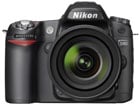Olympus E-510
-
-
Written by Gordon Laing
Olympus E-510 verdict
The Olympus E-510 is arguably the most feature-packed DSLR in its class, ticking almost every box on the wish-lists of new DSLR buyers. You get 10 Megapixels in a relatively light and compact form factor, the option of one or two decent kit lenses, and the triple whammy of built-in anti-shake, anti-dust and Live View capabilities, not to mention easy access to a wide variety of settings. It’s certainly a compelling package, especially for the asking price.
That’s not to say the E-510’s a no-brainer for new DSLR buyers though. Some may prefer the smaller form factor of the E-410. Others might not get on with the optical viewfinder and manual focusing of the Four Thirds system, or prefer a model with optically-stabilised lenses. As always, there’s pros and cons to every camera, so let’s compare the E-510 to a number of its closest rivals.
Compared to Olympus E-500
The Olympus E-510 is the successor the E-500, so it makes sense to start our comparisons here. The E-510 may share a number of design cues and advanced menu options with its predecessor, but packs in many more features. The E-510 adds Image Stabilisation, Live View and two extra Megapixels, not to mention smaller, lighter and better quality kit lens options. If you are an E-500 owner and fancy a sleeker version with anti-shake, live view and slightly higher resolution images, the E-510 should be top of your list. See our Olympus E-500 review for more details.
Compared to Olympus E-410
The Olympus E-410 may be over-shadowed by its bigger brother’s anti-shake facilities, but there’s still plenty to like here – or even prefer. The E-410 (and earlier E-400) are the world’s smallest and lightest DSLRs and there’s no denying they have an X-factor that’s absent from the more traditional looking E-510. The E-410 and E-400 also have the advantage of an optional underwater case. Clearly the E-510 has the upper hand with its built-in anti-shake, but if you can live without it, the E-410 gets you the same sensor, image processing, anti-dust and Live View facilities in a smaller and lighter package. As such the E-410 will appeal both to those who want the tiniest DSLR, but equally pros who are looking for a backup body; it’s cheaper too. See our Olympus E-410 review for more details. |
Compared to Canon EOS 400D / XTi
 |
Canon’s EOS 400D / Rebel XTi is the best-selling 10 Megapixel DSLR right now, so a natural rival to the E-510. The Canon comes in comfortably cheaper than the E-510 and offers roughly similar quality, along with a far superior 9-point auto-focus system and bigger viewfinder. Beyond this though, the E-510 has the edge. It features built-in anti-shake, Live View and superior anti-dust capabilities, not to mention a better kit lens. The E-510 is far better-featured overall, so if you’re considering the Canon but can afford a little more, you should definitely also take a look at the Olympus. See our Canon EOS 400D / XTi review for more details.
Compared to Sony Alpha A100
The Sony Alpha A100 is currently the cheapest 10 Megapixel DSLR with built-in anti-shake facilities. It’s available for comfortably less than the Olympus E-510, and again like the Canon features superior AF and a bigger viewfinder. As before though, the E-510 out-features it with Live View, superior anti-dust facilities and the ability to preview the anti-shake system on-screen. If you’re after the most affordable 10 Megapixel DSLR with anti-shake, then the Sony’s your camera, but if you can stretch to the E-510, you’ll be getting a more capable model. See our Sony Alpha A100 review for more details. |
|
 |
Nikon’s D40x simply can’t compete in terms of features and gadgets, but combines affordability with great ease of use. The D40x (and the D40) are arguably the friendliest DSLRs around right now and are almost foolproof too thanks to Nikon’s legendary metering system. While the E-510 employs a similar basic 3-point AF system, it of course packs in considerably more features including anti-shake, anti-dust and Live View. But the bottom line is the Nikon remains easier and more foolproof to use, so if you’re a DSLR beginner, the D40x should seriously be considered. See our Nikon D40x review and Nikon D40 review for more details.
Compared to Nikon D80
Finally we come to the Nikon D80, which actually costs a little more than the E-510. In its favour, the D80 offers unrivalled handling and build quality for the money, and like the D40(x), features Nikon’s superb metering system. The D80 additionally boasts the biggest, brightest optical viewfinder and most sophisticated AF system of the models listed here. But like the D40(x), it’s beaten by the E-510 in the gadgetry stakes. The Olympus features built-in anti-shake, anti-dust and Live View facilities, while also offering a number of advanced menu options which will appeal to enthusiasts. The decision here then boils down to modern features versus traditional photography done very well. If you have no need for Live View, are happy retouching dust and prefer lens-based stabilisation, then you’ll probably be better-off with the D80. If however you value the E-510’s unique features, it’s the one to go for. See our Nikon D80 review for more details. |
Olympus E-510 final verdict
The Olympus E-510 certainly has a great deal going for it: anti-shake, Live View, the most effective anti-dust system around, and decent kit lens options. The image quality is also very good, and by reducing the noise filter and sharpening settings, it can get a whole lot better.
Indeed there’s not a lot wrong with the E-510. The viewfinder, like other Four Thirds DSLRs, may be smaller than the competition, but you do have the option of Live View as an alternative. The motorised manual focusing may not be to your taste, but the Live View focus assist and quality of the kit lenses could win you round.
 |
The anti-shake, like other in-camera systems, may not be as effective as lens-based stabilisation, especially at longer focal lengths, nor be visible through the optical viewfinder, but again you can see the effect on-screen and you’re enjoying the benefit on any lens you attach. Finally, it’s shame the E-510’s screen doesn’t flip out, but Olympus had to save something for the Pro model.
So if you’re being picky, you can certainly find fault with the E-510, and of course when you come to pick it up in person, you might simply prefer the look and feel of its rivals. But its unrivalled feature-set and affordable pricing makes it one of the most compelling – not to mention important – DSLRs to date. It propels both Olympus and the Four Thirds standard to the premier league and should be seriously considered by anyone in the market for a new 10 Megapixel DSLR. To see a demonstration of its highlight features, check out our Olympus E-510 video tour.
Good points Bad points |  Scores | |||
Build quality: Image quality: Handling: Specification: Value:
Overall: |
16 / 20 18 / 20 16 / 20 20 / 20 19 / 20
89% | |||







